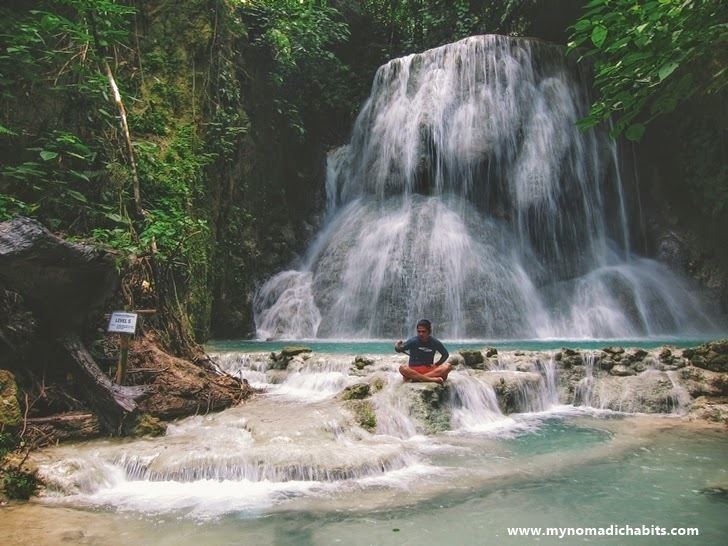Country Philippines Time zone PST (UTC+8) Area 45.16 km² Province Cebu | District 2nd district of Cebu ZIP code 6027 Local time Saturday 11:37 AM | |
 | ||
Region Central Visayas (Region VII) Barangay Weather 29°C, Wind N at 11 km/h, 80% Humidity Neighborhoods Tangbo, Dalahikan, Jumangpas, Poblacion, Camburoy, Colase, Monteverde, Bonbon, Basak, Calatagan Points of interest Dao Falls, Campanario de Antigua, Ponong Lake, Aguinid Waterfalls, Binalayan Falls (Hidden F | ||
Ferry at bato wharf samboan cebu philippines 2
Samboan is a 5th municipal income class municipality in the province of Cebu, Philippines, 150 kilometres (93 mi) south of Cebu City. According to the 2015 census, it has a population of 20,884. In the 2016 electoral roll, it had 12,577 registered voters.
Contents
- Ferry at bato wharf samboan cebu philippines 2
- Map of Samboan Cebu Philippines
- History
- Barangays
- Demographics
- Heritage buildings
- Attractions
- Town Fiesta
- Delicacies
- References
Map of Samboan, Cebu, Philippines
History
Samboan is an abbreviation of the word sinamboang, which was a ritual dance performed by the people of the village.
Samboan is a small town on a hill. But it used to be a much bigger town, with Oslob and Alegria under its territorial jurisdiction. In fact, people of Alegria were made to render forced labor for the construction of the Samboan church. It was only some time during the middle of the 1880s that those two towns were separated from Samboan (the towns of Ginatilan and Malabuyoc, which now lie in between, were created after the separation).
Barangays
Samboan comprises 15 barangays:
Demographics
In the 2016 electoral roll, it had 12,577 registered voters, meaning that 60% of the population are aged 18 and over.
Heritage buildings
One aspect of interest is that of Samboan's cultural heritage left by the Spanish conquerors. St. Michael Archangel Church is one of the oldest Spanish-built churches in Cebu, with its façade made of coral stones.
The Watch Tower is another Spanish structure, also made up of blocks of coral stones. It was built on the side of the hill to watch out for Moro invaders approaching the island. It is the tallest watch tower in the entire island of Cebu, and best preserved.
Connecting the beach area with the Spanish Watch Tower is St. Jacob's Ladder (Escala de Jacobe). It is a flight of 147 stone steps built in 1878, which leads to the old watchtower on a plateau 65 metres (213 ft) above the town. From here, one can get a view of the Tañon Strait.
The Samboan WWII Volunteers Monument, at the center of Poblacion on the National Highway, was built in honor of the many volunteers who fought for the freedom of the Philippines.
The San Sebastian Stone Walls are old stone structures near San Sebastian Parish Church. This may be why this barangay is popularly known as 'Bato' (meaning "stone").
Another Spanish structure is an old coral stone believed to be a Spanish Boundary Post. It stands along the highway in Tangbo beside the Tangbo—Bonbon River Bridge. It was believed that it used to mark the boundary limit of old poblacion but now merely serves to mark the boundary between Bonbon and Tangbo barangays.
Attractions
Samboan is known for its beautiful crystal clear waters with a rich marine ecosystem along its coastal barangays.
Colase Marine Sanctuary is managed by the municipality together with a fisherfolks organization.Here one can visit the fish sanctuary or dive for a fee to experience the most preserved marine ecosystem where sharks, dolphins and whales in the shallowest part of the foreshore.
Aguinid Waterfalls in Tangbo comprises five different tiers along Tangbo river. Each tier has a unique waterfall. One can never reach the peak or last waterfall without climbing the limestone walls of each waterfall from the lowest to highest.
Bonbon Hidden Falls to the immediate south of Poblacion which some visitors call the Triple Drop Falls.
Ponong Hidden Lake is not actually a lake, but a type of a closed lagoon. Its water is brackish. It is unique in the sense that here is where a certain kind of bird – the "manolong" – dives into its salty waters and stays under for a long time in order to escape hunters.
Balay'g Sawa Falls has a smaller waterfall but has a bigger lagoon for swimming.
Mt. Bartolina situated in between Bulangsuran and Canang (Oslob) is where one can climb the peak and see both sides of Cebu, facing Bohol Strait to the east and Tañon Strait to the west. Bartolina is the highest peak in the south of Cebu where the panoramic view of north and south Bais Bay and the rest of Negros, Siquijor, and Bohol islands can be seen.
Dau Falls is the highest waterfall in Samboan.
Tabon Falls is a recently developed natural spot found between Tangbo and Bonbon.
Town Fiesta
The town fiesta is celebrated each 29–30 September in honor of the patron saint, Michael (San Miguel, ang Arkanghel).
